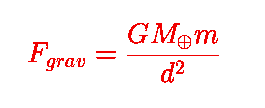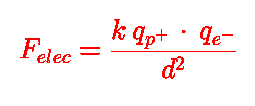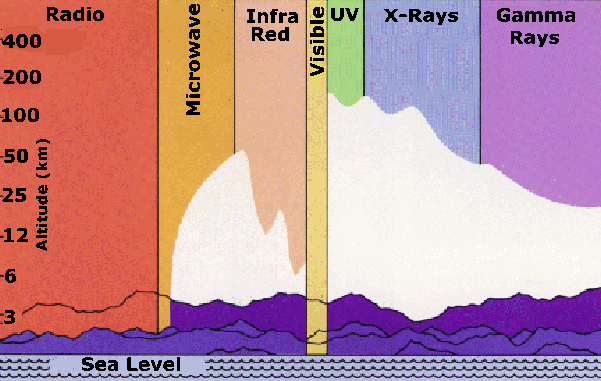Newton's Laws, Basic Forces & Light

Newton's Laws, Basic Forces & Light |

NEWTON'S
LAWS OF MOTION
Here's
another look at
Newton's Laws.
Here is another look at Newton's First Law.
|
When body A exerts a force on body B,
body B exerts an equal and opposite force on body A.
Often stated as the Law of Action and Reaction, the Third Law is responsible for Conservation of Momentum and is the Principle that makes Rocket Flight possible. |  |
As far as we know, there are four Fundamental Forces:
 |
Gravity
Weak Nuclear Force Electromagnetism (or Electricity) The Strong Nuclear Force |
 |
 |

|
 |
 |
where is the mass of the
Earth, and
is the mass of the
Earth, and  is
the mass of the Moon, d is the distance between the Earth and the Moon,
and G is Newton's Gravitational constant
(G = 6.67 x 10-8dyne.cm2/g2)
Gravity is such a weak force that Newton's constant could not be measured
at that time. The first to estimate the value of G was astronomer
Nevil Maskelyne. He used the deflection of a plumbline on the
slopes of Mt. Schiehallion in Scotland to determine the gravitational
attraction between the plumbob and the mountain in 1774. From Schiehallion's
very regular shape, Maskelyne was able to estimate the mountain's mass and
thus determine the value of G.
Henry
Cavendish was the first to measure G in the laboratory
is
the mass of the Moon, d is the distance between the Earth and the Moon,
and G is Newton's Gravitational constant
(G = 6.67 x 10-8dyne.cm2/g2)
Gravity is such a weak force that Newton's constant could not be measured
at that time. The first to estimate the value of G was astronomer
Nevil Maskelyne. He used the deflection of a plumbline on the
slopes of Mt. Schiehallion in Scotland to determine the gravitational
attraction between the plumbob and the mountain in 1774. From Schiehallion's
very regular shape, Maskelyne was able to estimate the mountain's mass and
thus determine the value of G.
Henry
Cavendish was the first to measure G in the laboratory
Despite the fact that Gravity is the weakest of the fundamental forces, because it is a purely attractive, long-range force, we will see that Gravity dominates many areas of astronomy. These include the orbits of planets,stars, and galaxies, the life cycles of stars, and the evolution of the Universe.
The Electromagnetic Force
The electric force between electrons and protons is given by
 |
 |

|
 |
 |
where q is electrical charge, d is distance and k is a constant for electricity (analogous to G for gravity). The form of the equation for electrical force is the same as that for gravity, but there are some key differences:
 + + + +

|
 - - - -

|
- 
 + +
|
The Weak Force
The Weak Force is about 10-13 times as strong as the
Electromagnetic force, with a range of only 10-16 centimeters.
The Weak Force moderates certain kinds of nuclear decays such as the neutron
decay shown below. The most common particle which interacts only via the Weak
Force is the neutrino, symbol Greek "nu" below. We shall hear more
about the neutrino when we talk about Nuclear Reactions & Stellar
Evolution and Cosmology.

We now know that the Weak Force is an aspect of a "unified force" called the "Electro-Weak Force" which combines the properties of the Weak Force and the Electromagnetic Force. Many physicists believe that all of the forces are really different aspects of a single "Grand Unified Force." Progress is being made toward combining the Strong Nuclear Force with the Electroweak Force, but as yet how to include Gravity remains a problem.
The Strong (Nuclear) Force
The Strong Nuclear Force (also called the "nuclear force" or the "strong
force") holds the atomic nucleus together. To do this, it must overcome the
tremendous repulsion that arises when the positively charged protons
are packed together into the small space of the nucleus. While the nuclear
force is the strongest of the fundamental forces, it has a very short range,
effectively only the scale of the atomic nucleus ~ 10-13
cm. So,
the strong force can only overcome the electrical repulsion when the protons
are close enough to be "touching". Because neutrons interact with protons via
the Strong Force, but have no charge, more and more neutrons are necessary to
"dilute" the repulsive forces and hold heavy nuclei together.
For this part of the tutorial we will treat light in terms of its
wave
properties. (We will see in the tutorial on Atomic
Structure that light
also behaves as a "particle" called a photon).

We characterize a wave by its:
 ; - Greek "nu"):
the number of wavecrests per second (units: Hz or 1/s).
; - Greek "nu"):
the number of wavecrests per second (units: Hz or 1/s).
 - Greek
"lambda"): distance between wavecrests (units: cm or Å
Ångstroms =
10-8cm; you will also see nm = 10-9m =
10-7cm = 10Å)
- Greek
"lambda"): distance between wavecrests (units: cm or Å
Ångstroms =
10-8cm; you will also see nm = 10-9m =
10-7cm = 10Å)
 wavecrests pass a point
each second,
each separated by
wavecrests pass a point
each second,
each separated by  cm,
then the speed must be:
cm,
then the speed must be:
 x
x
 =
frequency x wavelength
=
frequency x wavelength
The wave can also be characterized by its energy, E:

where h = 6.625 x 10-27erg-sec is Planck's Constant. For example KGB radio, 101.5 FM, has a frequency = 101.5 megahertz = 101,500,000 cycles/sec. This must correspond to a wavelength of about 295cm between peaks in the electric and magnetic fields of the wave. The energy of this radio photon is 6.7 x 10-19erg. Considering that an erg is about the energy that a fly expends taking off from a wall, it's apparent that radio waves don't carry much energy. (Considering the long wavelengths of radio waves, it also doesn't make much sense to talk about radio photons!)
Visible light, radio waves, microwaves, x-rays; they are all
electromagnetic radiation. They each have a certain range of
wavelengths and energies, and they represent a region in the Electromagnetic
Spectrum:


To understand more about Infrared Light see this excellent Infrared Tutorial from NASA's Infrared Processing & Analysis Center at Caltech. The Chandrasekhar X-Ray Observatory's X-Ray Field Guide will tell you what you need to know about x-rays.
 Transmission of the Earth's atmosphere; the white region indicates the altitudes where light from the different spectral region does not penetrate. From NASA's Imagine |
Atoms and ions in the Earth's upper atmosphere absorb gamma-rays, x-rays, and ultraviolet light; the atmosphere is opaque to these three forms of radiation. (The UV which is responsible for sunburn and skin cancer is "very-violet" visible light by our astronomical definition.) The atmosphere is transparent to visible light. Molecules (H2O, CO2, CH4...) absorb most wavelengths of infrared light; there are windows at 1.25µm, 1.65µm, 2.0-2.5µm, 3-4µm, 4.5-5.5µm,8-12µm, and 17-25µm. Then the atmosphere is largely opaque out to millimeter wavelengths. The atmosphere is transparent through the Radio to meter wavelengths, where the ionisphere reflects radio waves.
Atmospheric Seeing The Earth's atmosphere has another negative effect on astronomical research. Turbulence in the Earth's atmosphere produces the twinkling of the stars which astronomers call seeing. Turbulent cells in the Earth's atmosphere act like small lenses, refracting light rays as they pass through and blurring an image. This site has a graphic demonstration of the effects of seeing on photographs, and here is an mpeg animation of Betelgeuse, from the 4-m Herschel Telescope in the Canary Islands,courtesy of the Applied Optics Group, Imperial College, London.


![]() Telescopes
Telescopes
![]() History
History
![]() Education & Outreach
Education & Outreach
![]() CASS Home
CASS Home